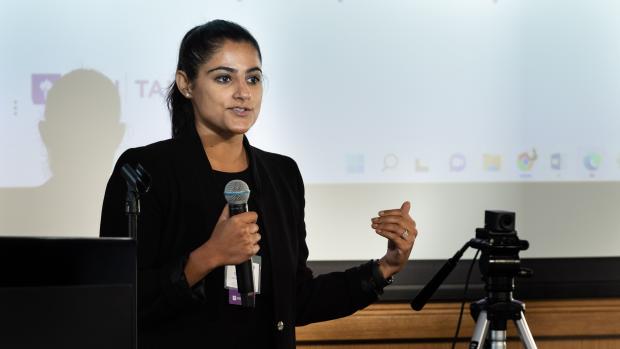Meet NYU Tandon’s Assistant Dean of Digital Learning
Shivani Dhir has deep ties to the university and an abundance of innovative ideas

Shivani Dhir arrived at NYU Tandon in early 2022 to take on the role of Assistant Dean of Digital Learning. Overseeing non-traditional learning opportunities in engineering and technology through innovative degree, non-degree, and executive programs in flexible online and hybrid formats; offering pathways for students and professionals with both STEM and non-STEM backgrounds to enable career growth; collaborating with a wide variety of industry partners–it’s now all in a day’s work for Dhir. We recently caught up with her to learn more about her vision, plans, and goals.
Q: At Tandon, we often discuss the importance of lifelong learning. How does digital learning fit into that?
A: When most people think of an engineering education, they probably envision that period from the undergraduate years to doctoral studies and maybe, in some cases, post-doctoral work. But that’s a very narrow window when you consider a person’s professional journey as a whole.
NYU has always been an innovator in the space of lifelong learning – creating ways for people to act on their curiosity in a subject or build their knowledge at different periods of their lives and careers. And before NYU and Polytechnic University merged most recently to become NYU Tandon, Poly was one of the first engineering schools to develop rigorous instructional design methods for teaching online and hybrid engineering courses.
At Tandon, on one end of the spectrum, you have the school’s Center for K12 Education, which is aimed at the very youngest aspiring scientists and engineers, and then, at the other end, there are the online degree and certificate programs for established professionals, which come under the purview of Digital Learning. Whether you are interested in helping safeguard your organization as a Chief Information Security Officer (CISO), need to understand energy markets better, or want to produce high quality video content, we have a program that will fit the bill.
Some of the areas of our portfolio that I’m proudest of are our Bridge program, which prepares anyone–even those from non-technical backgrounds like humanities majors–and prepares them for challenging STEM master’s degrees, and our Cyberfellows initiative, which makes it possible to earn a cybersecurity master’s degree in an exceptionally flexible and affordable way. Our Digital Learning portfolio can basically help a student go from an entirely non-STEM background into a highly-sought cybersecurity job–and then even progress into a leadership role if they’re interested through the CISO program or Management of Technology master’s degree.
Q: You sometimes use the terms “undiscovered” or “unconventional” engineer. What does that mean exactly?
A: It’s become something of a truism that every job is now in some way a tech job. It’s not that long ago that technology was a highly specialized field. Now, almost every company across sectors relies on IT infrastructure and data analytics to support business outcomes, and almost every organization needs to account for risks associated with cybersecurity. Most of us spend at least some of our time every day engaging with technology. By default, we have to become adept with it at some level; we have to learn the appropriate skills to remain effective in our professional lives. Once that happens, you might find some unexplored part of yourself that thinks and functions like an engineer.
I shied away from STEM for years because I wasn’t great at physics or calculus in high school, so I understand the reluctance to dive into an area you haven’t been used to thinking is for you. Luckily, that attitude is changing, and we know that technology is for everyone, no matter your background.
Q: How did your own background prepare you for your current role?
A: I came to the U.S. at the age of 14 and graduated high school on Long Island. NYU always had a global reputation, and I was lucky enough to earn my bachelor’s degree from the College of Arts & Sciences and an MBA from Stern. That began my long affiliation with the university, and it’s where I launched my professional career in higher ed.
After working at NYU in program development and management for many years, I went on to launch and lead an innovative executive program in healthcare leadership at Cornell. Eventually, I made a slight pivot and went on to lead the higher education vertical at a marketing agency partnering with a variety of universities and programs as clients. That role gave me the unique opportunity to observe and understand dynamics at play across the higher education landscape from a broader perspective.
Throughout my 15 years in higher education, I developed an understanding of what was meaningful to, and what worked for adult learners, specifically working professionals and executives.
Working professionals value flexibility, balancing work-life-school, and are very focused on either advancing their career in a specific way, or on pivoting into a new fast-growing area where their past experience is transferable. While academic rigor is respected, didactic learning isn’t for this audience; with some work experience under their belt, their focus is on application and the big picture and want a well rounded experience. They want to learn from the faculty but also from their peers. The network and industry relationships that an institution can offer are incredibly important to them.
Online learning is a very competitive market, so the program experience has to live up to high standards. Just like healthcare is moving towards precision medicine, there is a demand for more precise and tailored learning. Whether you're a company looking to train your workforce in a new skill area or you're a student aspiring to a specific job or career progression, online programs that see the greatest success are those that consider the student holistically, provide high touch experiences, and intentionally create a technology-enabled learning experience. Just delivering course material over zoom, like we saw in response to COVID, isn’t going to work.
I think one of the best ways to describe NYU is “impactful.” Throughout the university, everyone is engaged in big-picture thinking, and that makes it easy to have an impact in your chosen area, which in my case is expanding lifelong learning and access to STEM careers through innovative programs.
Q. You talked about people pivoting in their careers, and in some ways you have as well, in terms of pivoting to digital learning in STEM. What made you want to do that?
A: There were a few factors that went into that decision.
First, to the earlier question about lifelong learning, there is no such thing as a terminal degree in STEM anymore. Both working professionals and organizations are investing in continuous learning. Mid-career professionals no longer see their career as linear, and while stability is important, the focus is much more on perpetual innovation, especially for engineers, IT professionals, medical practitioners, developers, and others in STEM fields. Skilling up is now the norm in these sectors because things are moving so fast. And companies are increasingly recognizing that it’s of necessity and mutual benefit to offer employees the chance to learn and get adept at new technologies.
Moreso in STEM than anywhere else, education programs have to be responsive to industry – if we are not teaching skills that enable students to be successful professionals and leaders, we are not doing our job as an academic institution. I love being in a position to help bridge those skill gaps, and help people advance in careers while helping companies meet their strategic business outcomes.
As I mentioned earlier, I am also very excited about opening doors into STEM for people who haven’t traditionally felt welcome or haven’t seen themselves as engineers or technologists. I think the flexibility of digital learning lends itself to making upskilling in new technologies and platforms more accessible to a more diverse audience, and I think it creates a practical and actionable opportunity for organizations to diversify their workforce in ways that will benefit their employees, their company cultures and their bottom line.
Q: Do you have an overarching goal?
A: If I had to put it in a nutshell, I’d say it’s to remove barriers to entry into the tech fields and to make it possible for anyone, in any field, with any background, to leverage the power of tech skills to enable career growth. I want to help professionals navigate change effectively, since few career paths are completely linear now, and offer them the knowledge they need to make bold career pivots towards the jobs of the future.
Q: What are you most excited about lately?
A: We’re just launching an interdisciplinary master’s program in emerging technology, aimed at graduating well-rounded professionals capable of stepping into the kind of cross-functional roles and teams that are expected in today’s industry landscape. The curriculum includes courses in an incredible array of topics, including distributed operating systems, urban informatics, big data, algorithm design, AI and machine learning, programming languages, visualization, penetration testing, and a lot more. It’s really exciting because it’s one of only a handful of “build your own” master’s degrees in technology that allows students in the program to pick a concentration, like AI, but then supplement it with electives in other areas, like user experience or change management, that collectively can equip them with very unique expertise to excel in something like product management, or an innovation role in a large company. Since most engineering degrees are very discipline specific, it’s great to be able to introduce a different way to get a rigorous but adaptable technology degree.
Q: Can advances in online learning have an impact on traditional, in-person programs?
A: Absolutely. Digital learning does not simply mean remote or online learning. All educational offerings can be enhanced with technology. We often work with faculty members teaching both online and in-person classes, offering all of our support and resources, including expert instructional designers and a state-of-the-art recording studio.
For instance, I’ve found the concept of the “flipped” classroom really compelling; that’s where students listen to lectures or work on baseline skills asynchronously first, then use their classroom time to collaborate with their professor and classmates, get hands-on, and engage more deeply with the material.
Everything we do is faculty-driven. They’re the deep subject matter experts, and we support them by providing the framework and infrastructure to deliver high-quality, innovative programs. It’s essential for everyone, no matter what role they’re working in, to expand their toolkit – it's been exciting to see faculty embrace this too.
It’s also exciting to be able to introduce something in one format, and through feedback and evaluation understand its potential to be optimized and introduced in another format. I definitely see opportunities for us to take what we’re doing in the digital learning area and collaborate with faculty and leadership to identify the right way and time to incorporate those ideas into the in-person experience.


